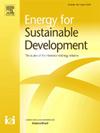The role of coal plant retrofitting strategies in developing India’s net-zero power system: A data-driven sub-national analysis
IF 4.9
2区 工程技术
Q2 ENERGY & FUELS
引用次数: 0
Abstract
India set Nationally Determined Contribution (NDC) targets toward its net-zero carbon emission goal by 2070, which requires deep decarbonization of India’s power generation sector. Yet, coal power generation contributes to more than 60% of the total, and policies still permit further coal fleet expansion and lifetime extensions. In this paper, we investigate the role of retrofitting India’s coal plants for carbon capture and storage (CCS) and biomass co-firing in developing the net-zero power system. We model the power generation and transmission network expansions across 30 Indian regions in four representative technology scenarios under progressively tighter carbon emission caps, taking into account sub-national coal price variation and thermal efficiency of individual coal plants. Our analysis indicates that coal plant retrofitting with CCS could achieve gigawatt-scale deployment by 2035 if India reduces its annual carbon emissions from power generation to half of the 2021 level (i.e., 500 million tons of CO). Both renewable capacity expansion and coal plant retrofitting with CCS reduce the unabated coal plant capacity, electricity generation costs, and carbon abatement costs. While exploiting renewable energy potential remains the most cost-effective decarbonization strategy, it faces challenges of low coal plant utilization and the uneven geographical distribution of renewable generation investments.
煤电厂改造战略在发展印度净零电力系统中的作用:数据驱动的次国家分析
印度设定了到2070年实现净零碳排放的国家自主贡献(NDC)目标,这需要印度发电部门实现深度脱碳。然而,煤炭发电占总发电量的60%以上,政策仍然允许进一步扩大煤炭船队和延长寿命。在本文中,我们研究了对印度煤电厂进行碳捕集与封存(CCS)和生物质共烧改造在发展净零电力系统中的作用。我们在逐步收紧碳排放上限的情况下,在四种具有代表性的技术情景下,对印度30个地区的发电和输电网络扩张进行了建模,同时考虑了次国家煤炭价格的变化和单个煤电厂的热效率。我们的分析表明,如果印度将其每年的发电碳排放量减少到2021年水平的一半(即5亿吨二氧化碳),那么用CCS改造的煤电厂可以在2035年实现千兆瓦级的部署。可再生能源产能的扩张和煤电厂的CCS改造都能降低未减煤电厂的产能、发电成本和碳减排成本。虽然开发可再生能源潜力仍然是最具成本效益的脱碳战略,但它面临着煤电厂利用率低和可再生能源发电投资地域分布不均匀的挑战。
本文章由计算机程序翻译,如有差异,请以英文原文为准。
求助全文
约1分钟内获得全文
求助全文
来源期刊

Energy for Sustainable Development
ENERGY & FUELS-ENERGY & FUELS
CiteScore
8.10
自引率
9.10%
发文量
187
审稿时长
6-12 weeks
期刊介绍:
Published on behalf of the International Energy Initiative, Energy for Sustainable Development is the journal for decision makers, managers, consultants, policy makers, planners and researchers in both government and non-government organizations. It publishes original research and reviews about energy in developing countries, sustainable development, energy resources, technologies, policies and interactions.
 求助内容:
求助内容: 应助结果提醒方式:
应助结果提醒方式:


